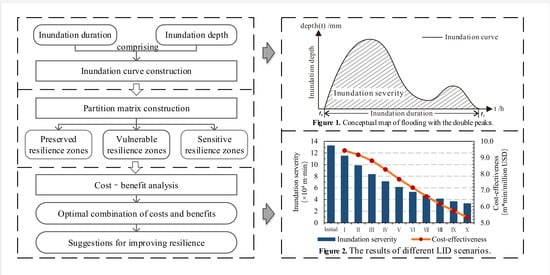Exploring the Optimal Cost-Benefit Solution for a Low Impact Development Layout by Zoning, as Well as Considering the Inundation Duration and Inundation Depth
Abstract
:1. Introduction
2. Materials and Methods
2.1. Study Area and Data Collection
2.2. Analytical Framework
2.3. Partition Matrix Construction
2.4. Simulations of LID Combination Scenarios
- Initial scenario: 0 GR + 0 PP + 0 VS
- Scenario I (I): 10%GR + 10%PP + 10%VS
- Scenario II (II): 20%GR + 20%PP + 20%VS
- Scenario III (III): 30%GR + 30%PP + 30%VS
- Scenario IV (IV): 40%GR + 40%PP + 40%VS
- Scenario V (V): 50%GR + 50%PP + 50%VS
- Scenario VI (VI): 60%GR + 60%PP + 60%VS
- Scenario VII (VII): 70%GR + 70%PP + 70%VS
- Scenario VIII (VIII): 80%GR + 80%PP + 80%VS
- Scenario IX (IX): 90%GR + 90%PP + 90%VS
- Scenario X (X): 100%GR + 100%PP + 100%VS
2.5. Cost-Benefit Analysis of Optimal LID Solution
3. Results
3.1. Spatial Distributions of Different ISI Values
3.2. Overall Impact of LID
3.3. Performance of Different Zones
3.4. Optimal Combination of Costs and Benefits
4. Discussion
4.1. Optimal Combination of Costs and Benefits
4.2. Necessity for Resilient Subdivisions
4.3. Reasons for Cost–Benefit Analysis of LID Construction
4.4. Limitations and Future Directions
5. Conclusions
- Overall, the degree of inundation reduction increased, but the rate of reduction decreased slowly as the density of LID construction increased. These findings demonstrated that the implementation of LID strategies obtained cost benefits;
- Optimal cost–benefit solutions exist for single LID strategies. When multiple LID strategies were implemented, the effect was not simply the sum of both, but instead synergistic or antagonistic effects were obtained;
- Dividing the study area based on the degree of flooding severity is essential because of the difference in performance in different zones at the urban watershed scale. We found the optimal solution in terms of the cost-benefit ratio in the Vulnerable Zones. However, the main purpose of this study was to find different optimal combinations for diverse study areas and to identify a universal law rather than determining specific values;
- The LID strategy achieved effective results at improving the inundation resilience, but it was unable to completely prevent flooding at all of the inundation points due to various factors, such as the construction scope, distribution pattern, and the type parameters. In future research, the comprehensive application of multiple resilience improvement strategies will be the main approach employed to build a resilient city by maximizing the resilience enhancement effect.
Author Contributions
Funding
Acknowledgments
Conflicts of Interest
Appendix A
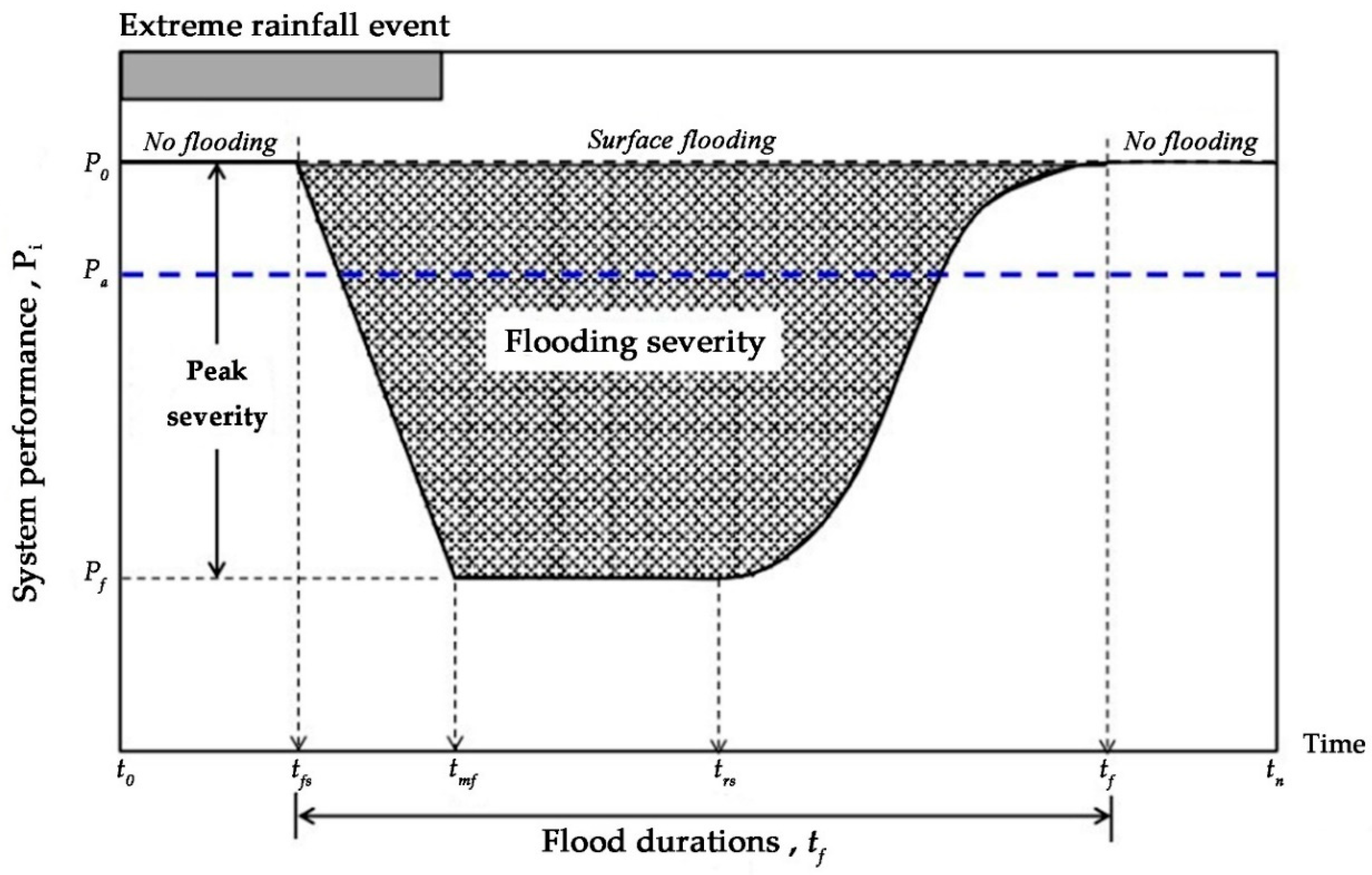
| Types | Structure | Parameters | Value | Unit |
|---|---|---|---|---|
| GR | Surface | Berm height | 3 | mm |
| Vegetation volume fraction | 0.1 | |||
| Surface roughness | 0.017 | |||
| Surface slope | 1 | % | ||
| Soil | Thickness | 100 | mm | |
| Porosity | 0.5 | |||
| Field capacity | 0.2 | |||
| Wilting point | 0.024 | |||
| Conductivity | 30 | mm/h | ||
| Conductivity slope | 5 | |||
| Suction head | 60 | mm | ||
| Drainage mat | Thickness | 3 | mm | |
| Void fraction | 0.5 | |||
| Roughness | 0.1 | |||
| PP | Surface | Berm height | 2 | mm |
| Vegetation volume fraction | 0 | |||
| Surface roughness | 0.014 | |||
| Surface slope | 1 | % | ||
| Pavement | Thickness | 100 | mm | |
| Void ratio | 0.25 | |||
| Impervious surface fraction | 0 | |||
| Permeability | 250 | mm/h | ||
| Clogging factor | 0 | |||
| Storage | Thickness | 150 | mm | |
| Void ratio | 0.4 | |||
| Seepage fate | 1.2 | mm/h | ||
| Clogging factor | 0 | |||
| VS | Surface | Berm height | 80 | mm |
| Vegetation volume fraction | 0 | |||
| Surface roughness | 0.24 | |||
| Surface slope | 1 | % | ||
| Soil | Thickness | 20 | mm | |
| Porosity | 0.5 | |||
| Field capacity | 0.2 | |||
| Wilting point | 0.1 | |||
| Conductivity | 5 | mm/h | ||
| Conductivity slope | 10 | |||
| Suction head | 3.5 | mm |
- Residences in urban villages would not be reconstructed with GR;
- The highways would not be reconstructed by PP for considering the pressure resistance of permeated pavement and other factors;
- PP could be used for reconstruction in several land use types with conditions such as the roads and parking lots in communities;
- vs. would be used in the green space in urban villages, commercial residential land, industrial land and water-permeable surfaces in park and green land.
| Types | Commercial Residential Land | Urban Village | Industrial Land | Park and Green Land | Roads | Others |
|---|---|---|---|---|---|---|
| GR | √ | — | √ | — | — | — |
| PP | √ | √ | √ | √ | — | — |
| VS | √ | √ | √ | √ | — | — |
| Types | Structures | Costs | Units |
|---|---|---|---|
| GR | Protection layer | 1.88 | USD/m2 |
| Plant | 6.57 | USD/m2 | |
| Soil | 86.30 | USD/m2 | |
| PP | excavation | 4.69 | USD/m2 |
| Filter fabric | 1.88 | USD/m2 | |
| Disposal | 15.95 | USD/m2 | |
| Asphalt pavement | 182.91 | USD/m2 | |
| VS | Plant | 6.57 | USD/m2 |
| Soil | 86.30 | USD/m2 | |
| excavation | 4.69 | USD/m2 |
| Intensity of GR | ISI (m·min) | Reduction (m·min) | Relative Cost (Million USD) | CEI (m·min/Million USD) |
|---|---|---|---|---|
| 0% | 33,371 | |||
| 10% | 31,130 | 2241 | 14.84 | 151.01 |
| 20% | 28,533 | 4838 | 29.68 | 163.01 |
| 30% | 26,861 | 6510 | 44.52 | 146.23 |
| 40% | 24,847 | 8524 | 59.36 | 143.60 |
| 50% | 22,940 | 10,431 | 74.20 | 140.58 |
| 60% | 21,219 | 12,152 | 89.04 | 136.48 |
| 70% | 19,672 | 13,699 | 103.88 | 131.87 |
| 80% | 18,274 | 15,097 | 118.86 | 127.01 |
| 90% | 17,046 | 16,325 | 133.70 | 122.10 |
| 100% | 15,926 | 17,446 | 148.54 | 117.45 |
| Intensity of VS | ISI (m·min) | Reduction (m·min) | Relative Cost (Million USD) | CEI (m·min/Million USD) |
|---|---|---|---|---|
| 0% | 28,533 | |||
| 10% | 28,452 | 82 | 2.94 | 27.891 |
| 20% | 28,386 | 148 | 5.74 | 25.784 |
| 30% | 28,309 | 224 | 8.68 | 25.806 |
| 40% | 28,185 | 348 | 11.48 | 30.314 |
| 50% | 28,090 | 443 | 14.42 | 30.721 |
| 60% | 28,004 | 529 | 17.22 | 30.720 |
| 70% | 27,938 | 595 | 20.16 | 29.514 |
| 80% | 27,863 | 670 | 23.10 | 29.004 |
| 90% | 27,790 | 743 | 25.90 | 28.687 |
| 100% | 27,708 | 825 | 28.84 | 28.61 |
References
- Arnell, N.W. The effect of climate change on hydrological regimes in Europe: A continental perspective. Glob. Environ. Chang. 1999, 9, 5–23. [Google Scholar] [CrossRef]
- Arnold, C.; Gibbons, C. Impervious Surface Coverage: The Emergence of a Key Environmental Indicator. J. Am. Plan. Assoc. 1996, 62, 243–258. [Google Scholar] [CrossRef]
- Beckers, A.; Dewals, B.; Erpicum, S.; Dujardin, S.; Detrembleur, S.; Teller, J.; Pirotton, M.; Archambeau, P. Contribution of land use changes to future flood damage along the river Meuse in the Walloon region. Nat. Hazards Earth Syst. Sci. 2013, 13, 2301–2318. [Google Scholar] [CrossRef]
- Claessens, L.; Hopkinson, C.; Rastetter, E.; Vallino, J. Effect of historical changes in land use and climate on the water budget of an urbanizing watershed. Water Resour. Res. 2006, 42, 1–13. [Google Scholar] [CrossRef] [Green Version]
- Willems, P.; Arnbjerg-Nielsen, K.; Olsson, J.; Nguyen, V.T.V. Climate change impact assessment on urban rainfall extremes and urban drainage: Methods and shortcomings. Atmos. Res. 2012, 103, 106–118. [Google Scholar] [CrossRef]
- Bhattarai, R.; Yoshimura, K.; Seto, S.; Nakamura, S.; Oki, T. Statistical model for economic damage from pluvial floods in Japan using rainfall data and socioeconomic parameters. Nat. Hazards Earth Syst. Sci. 2016, 16, 1063–1077. [Google Scholar] [CrossRef] [Green Version]
- Coles, D.; Yu, D.; Wilby, R.L.; Green, D.; Herring, Z. Beyond ‘flood hotspots’: Modelling emergency service accessibility during flooding in York, UK. J. Hydrol. 2017, 546, 419–436. [Google Scholar] [CrossRef] [Green Version]
- Kristvik, E.; Johannessen, B.G.; Muthanna, T.M. Temporal downscaling of IDF curves applied to future performance of local stormwater measures. Sustainability 2019, 11, 1231. [Google Scholar] [CrossRef] [Green Version]
- Gu, C.; Cockerill, K.; Anderson, W.P.; Shepherd, F.; Groothuis, P.A.; Mohr, T.M.; Whitehead, J.C.; Russo, A.A.; Zhang, C. Modeling effects of low impact development on road salt transport at watershed scale. J. Hydrol. 2019, 574, 1164–1175. [Google Scholar] [CrossRef]
- Luan, Q.; Fu, X.; Song, C.; Wang, H.; Liu, J.; Wang, Y. Runoff effect evaluation of LID through SWMM in typical mountainous, low-lying urban areas: A case study in China. Water 2017, 9, 439. [Google Scholar] [CrossRef] [Green Version]
- Zeng, S.; Guo, H.; Dong, X. Understanding the synergistic effect between LID facility and drainage network: With a comprehensive perspective. J. Environ. Manage. 2019, 246, 849–859. [Google Scholar] [CrossRef] [PubMed]
- Holling, C.S. Resilience and stability of ecological systems. Futur. Nat. Doc. Glob. Chang. 2013, 4, 245–256. [Google Scholar] [CrossRef] [Green Version]
- Meerow, S.; Newell, J.P.; Stults, M. Defining urban resilience: A review. Landsc. Urban Plan. 2016, 147, 38–49. [Google Scholar] [CrossRef]
- Vis, M.; Klijn, F.; De Bruijn, K.M.; Van Buuren, M. Resilience strategies for flood risk management in the Netherlands. Int. J. River Basin Manag. 2003, 1, 33–40. [Google Scholar] [CrossRef]
- Liao, K.H. A theory on urban resilience to floods—A basis for alternative planning practices. Ecol. Soc. 2012, 17. [Google Scholar] [CrossRef]
- Vamvakeridou-Lyroudia, L.; Chen, A.; Khoury, M.; Gibson, M.; Kostaridis, A.; Stewart, D.; Wood, M.; Djordjević, S.; Savic, D. Assessing and visualising hazard impacts to enhance the resilience of Critical Infrastructures to urban flooding. Sci. Total Environ. 2019, 707, 136078. [Google Scholar] [CrossRef]
- Godschalk, D.R. Urban hazard mitigation: Creating resilient cities. Nat. Hazards Rev. 2003, 4, 136–143. [Google Scholar] [CrossRef]
- Valdes, H.M.; Purcell, P.H. Making cities resilient report 2012: A global snapshot of how local governments reduce disaster risk. Int. J. Disaster Resil. Built Environ. 2013, 4, 240–246. [Google Scholar] [CrossRef]
- Bruneau, M.; Chang, S.E.; Eguchi, R.T.; Lee, G.C.; O’Rourke, T.D.; Reinhorn, A.M.; Shinozuka, M.; Tierney, K.; Wallace, W.A.; Von Winterfeldt, D. A Framework to Quantitatively Assess and Enhance the Seismic Resilience of Communities. Earthq. Spectr. 2003, 19, 733–752. [Google Scholar] [CrossRef] [Green Version]
- Reed, D.A.; Kapur, K.C.; Christie, R.D. Networked Infrastructure. IEEE Syst. J. 2009, 3, 174–180. [Google Scholar] [CrossRef]
- Ouyang, M.; Dueñas-Osorio, L.; Min, X. A three-stage resilience analysis framework for urban infrastructure systems. Struct. Saf. 2012, 36, 23–31. [Google Scholar] [CrossRef]
- Hammond, M.; Chen, A.; Djordjević, S.; Butler, D.; Mark, O. Urban flood impact assessment: A state-of-the-art review. Urban Water J. 2015, 12, 14–29. [Google Scholar] [CrossRef] [Green Version]
- Hu, M.; Sayama, T.; Zhang, X.; Tanaka, K.; Takara, K.; Yang, H. Evaluation of low impact development approach for mitigating flood inundation at a watershed scale in China. J. Environ. Manag. 2017, 193, 430–438. [Google Scholar] [CrossRef] [PubMed]
- Chen, W.; Huang, G.; Zhang, H.; Wang, W. Urban inundation response to rainstorm patterns with a coupled hydrodynamic model: A case study in Haidian Island, China. J. Hydrol. 2018, 564, 1022–1035. [Google Scholar] [CrossRef]
- Hwang, H.; Lansey, K.; Quintanar, D.R. Resilience-based failure mode effects and criticality analysis for regional water supply system. J. Hydroinform. 2015, 17, 193–210. [Google Scholar] [CrossRef] [Green Version]
- Mugume, S.N.; Gomez, D.E.; Fu, G.; Farmani, R.; Butler, D. A global analysis approach for investigating structural resilience in urban drainage systems. Water Res. 2015, 81, 15–26. [Google Scholar] [CrossRef] [PubMed] [Green Version]
- Leimgruber, J.; Krebs, G.; Camhy, D.; Muschalla, D. Model-based selection of cost-effective low impact development strategies to control water balance. Sustainability 2019, 11, 2440. [Google Scholar] [CrossRef] [Green Version]
- Joksimovic, D.; Alam, Z. Cost efficiency of Low Impact Development (LID) stormwater management practices. Procedia Eng. 2014, 89, 734–741. [Google Scholar] [CrossRef] [Green Version]
- Li, Q.; Wang, F.; Yu, Y.; Huang, Z.; Li, M.; Guan, Y. Comprehensive performance evaluation of LID practices for the sponge city construction: A case study in Guangxi, China. J. Environ. Manag. 2019, 231, 10–20. [Google Scholar] [CrossRef]
- Chui, T.F.M.; Liu, X.; Zhan, W. Assessing cost-effectiveness of specific LID practice designs in response to large storm events. J. Hydrol. 2016, 533, 353–364. [Google Scholar] [CrossRef]
- Cheng, M.; Qin, H.; He, K.; Xu, H. Can floor-area-ratio incentive promote low impact development in a highly urbanized area?—A case study in Changzhou City, China. Front. Environ. Sci. Eng. 2018, 12. [Google Scholar] [CrossRef]
- Xu, T.; Engel, B.A.; Shi, X.; Leng, L.; Jia, H.; Yu, S.L.; Liu, Y. Marginal-cost-based greedy strategy (MCGS): Fast and reliable optimization of low impact development (LID) layout. Sci. Total Environ. 2018, 640, 570–580. [Google Scholar] [CrossRef]
- Wu, J.; Yang, R.; Song, J. Effectiveness of low impact development for urban inundation risk mitigation under different scenarios: A case study in Shenzhen, China. Nat. Hazards Earth Syst. Sci. Discuss. 2018, 18, 2525–2536. [Google Scholar] [CrossRef] [Green Version]
- Liu, Y.Y.; Li, L.; Liu, Y.-S.; Chan, P.W.; Zhang, W.H. Dynamic spatial-temporal precipitation distribution models for short-duration rainstorms in Shenzhen, China based on machine learning. Atmos. Res. 2020, 237, 104861. [Google Scholar] [CrossRef]
- Lancia, M.; Zheng, C.; He, X.; Lerner, D.N.; Andrews, C.; Tian, Y. Hydrogeological constraints and opportunities for “Sponge City” development: Shenzhen, southern China. J. Hydrol. Reg. Stud. 2020, 28, 100679. [Google Scholar] [CrossRef]
- Song, J.; Chang, Z.; Li, W.; Feng, Z.; Wu, J.; Cao, Q.; Liu, J. Resilience-vulnerability balance to urban flooding: A case study in a densely populated coastal city in China. Cities 2019, 95, 102381. [Google Scholar] [CrossRef]
- Ding, S.; Ren, X.C. Research on Economic Incentive Policy for Low Impact Development of Rainwater Utilization in Guangming New District. China Water Wastewater 2015, 31, 104–107. [Google Scholar]
- Zhou, J. The practice of the sponge city—Taking the green ring of Shenzhen Guangming New District as an example. Jiangxi Build. Mater. 2016, 18, 42–45. [Google Scholar]
- Penning-Rowsell, E.; Viavattene, C.; Pardoe, J.; Chatterton, J.; Parker, D.; Morris, J. The Benefits of Flood and Coastal Risk Management: A Handbook of Techniques—2010; Middlesex University: London, UK, 2010. [Google Scholar]
- Nurmi, V.; Ahtiainen, H. Distributional Weights in Environmental Valuation and Cost-Benefit Analysis: Theory and Practice. Ecol. Econ. 2018, 150, 217–228. [Google Scholar] [CrossRef]
- Liu, Y.H.; Liao, W.Y.; Li, L.; Huang, Y.T.; Xu, W.J.; Zeng, X.L. Reduction measures for air pollutants and greenhouse gas in the transportation sector: A cost-benefit analysis. J. Clean. Prod. 2019, 207, 1023–1032. [Google Scholar] [CrossRef]
- Qin, H.; Li, Z.; Fu, G. The effects of low impact development on urban flooding under different rainfall characteristics. J. Environ. Manag. 2013, 129, 577–585. [Google Scholar] [CrossRef] [PubMed] [Green Version]
- Kong, F.; Ban, Y.; Yin, H.; James, P.; Dronova, I. Modeling stormwater management at the city district level in response to changes in land use and low impact development. Environ. Model. Softw. 2017, 95, 132–142. [Google Scholar] [CrossRef]
- Ahiablame, L.; Shakya, R. Modeling flood reduction effects of low impact development at a watershed scale. J. Environ. Manag. 2016, 171, 81–91. [Google Scholar] [CrossRef] [PubMed]
- Eckart, K.; McPhee, Z.; Bolisetti, T. Performance and implementation of low impact development—A review. Sci. Total Environ. 2017, 607–608, 413–432. [Google Scholar] [CrossRef]
- Townshend, D. Study on Green Roof Application in Hong Kong. In Architectural Services Department; Urbis Limited: Wan Chai, Hong Kong, 2007; pp. 1–157. [Google Scholar]
- Hu, M.; Zhang, X.; Li, Y.; Yang, H.; Tanaka, K. Flood mitigation performance of low impact development technologies under different storms for retrofitting an urbanized area. J. Clean. Prod. 2019, 222, 373–380. [Google Scholar] [CrossRef]
- Song, J.; Yang, R.; Chang, Z.; Li, W.; Wu, J. Adaptation as an indicator of measuring low-impact-development effectiveness in urban flooding risk mitigation. Sci. Total Environ. 2019, 696, 133764. [Google Scholar] [CrossRef]
- Eckart, K.; Mcphee, Z.; Bolisetti, T. Multiobjective Optimization of Low Impact Development Stormwater Controls. J. Hydrol. 2018, 562. [Google Scholar] [CrossRef]
- Pyke, C.; Warren, M.P.; Johnson, T.; LaGro, J.; Scharfenberg, J.; Groth, P.; Freed, R.; Schroeer, W.; Main, E. Assessment of low impact development for managing stormwater with changing precipitation due to climate change. Landsc. Urban Plan. 2011, 103, 166–173. [Google Scholar] [CrossRef]
- Rezazadeh Helmi, N.; Verbeiren, B.; Mijic, A.; van Griensven, A.; Bauwens, W. Developing a modeling tool to allocate Low Impact Development practices in a cost-optimized method. J. Hydrol. 2019, 573, 98–108. [Google Scholar] [CrossRef]
- Ma, Y.; Gong, M.; Zhao, H.; Li, X. Contribution of road dust from Low Impact Development (LID) construction sites to atmospheric pollution from heavy metals. Sci. Total Environ. 2020, 698, 134243. [Google Scholar] [CrossRef] [PubMed]
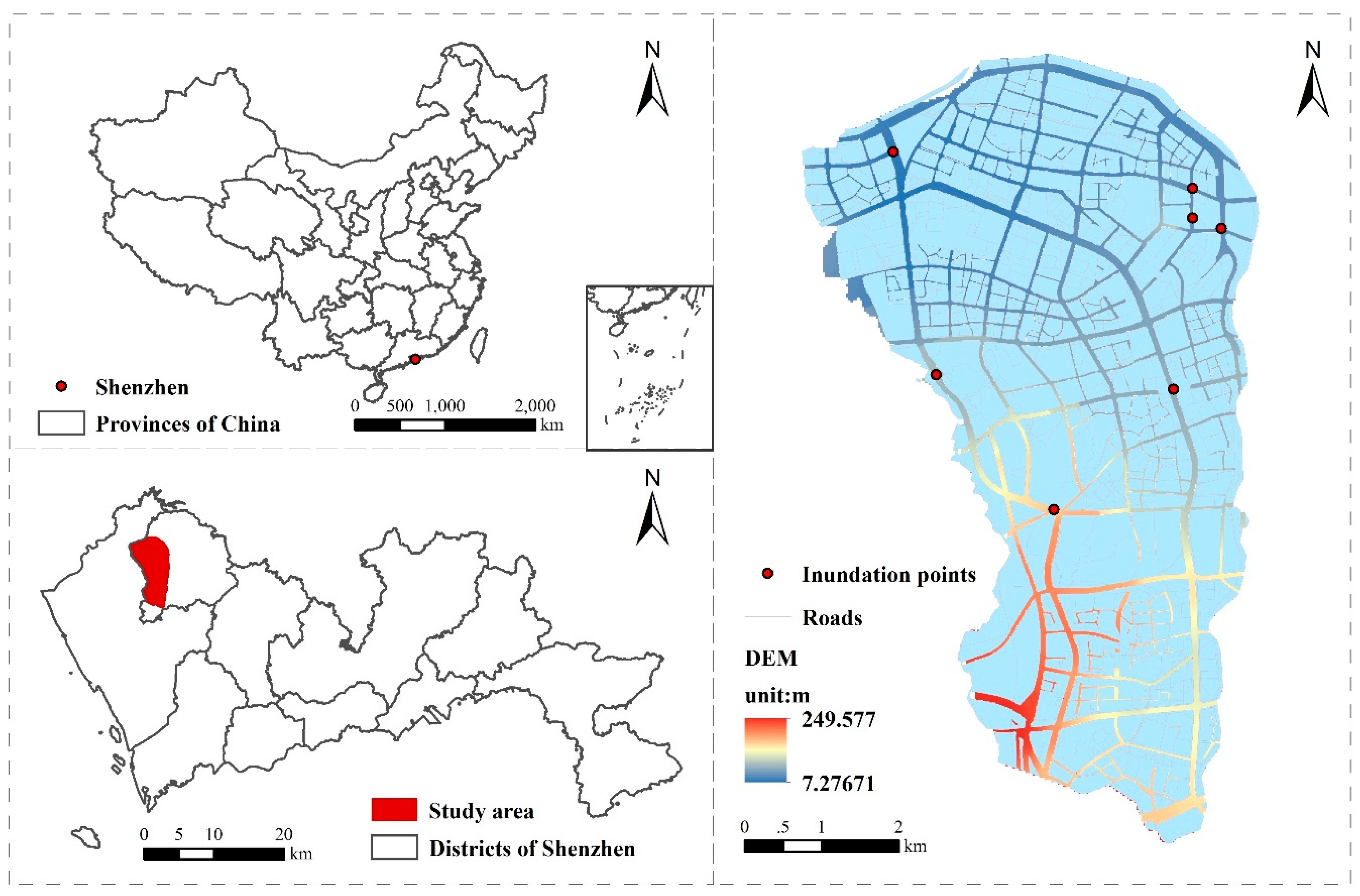

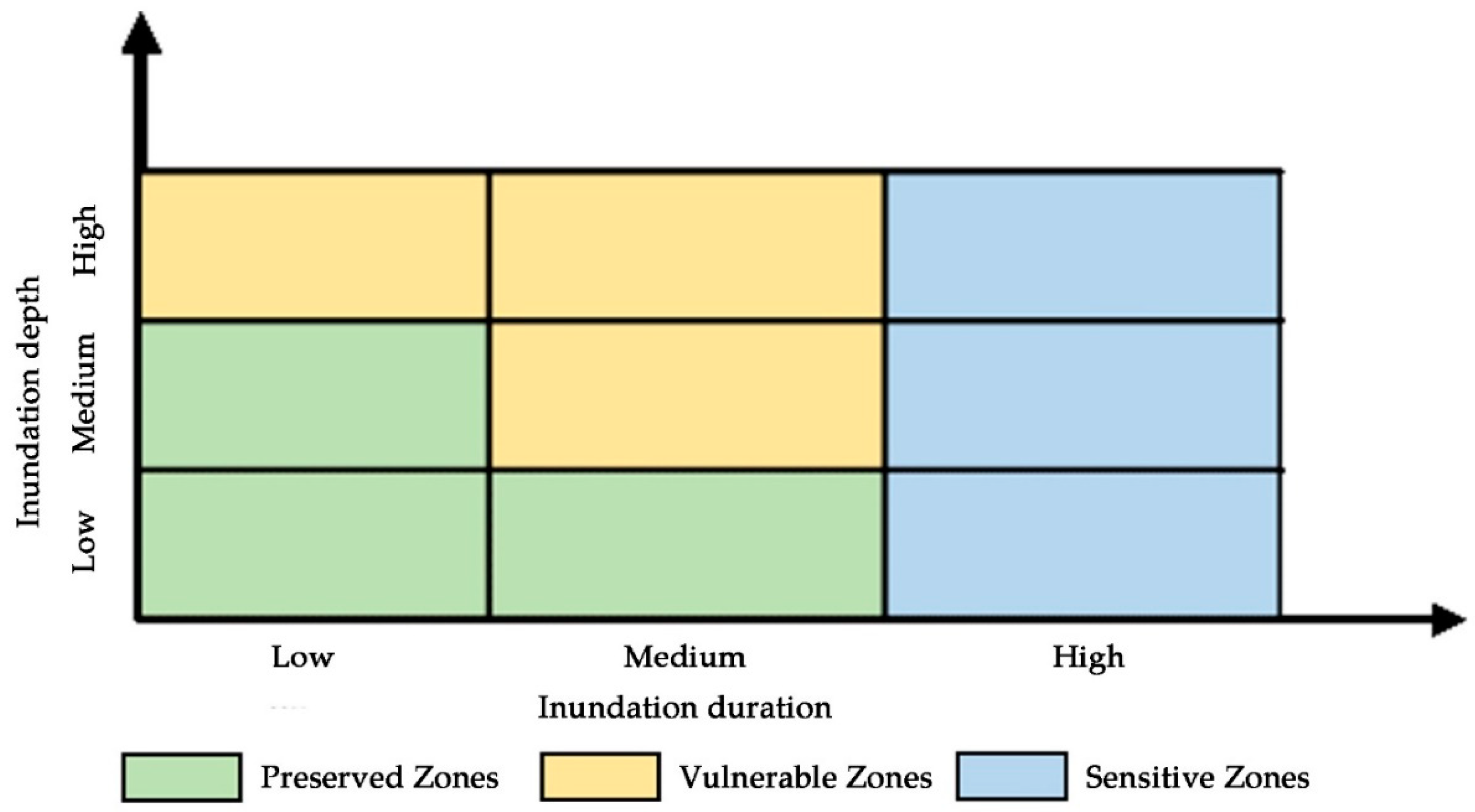

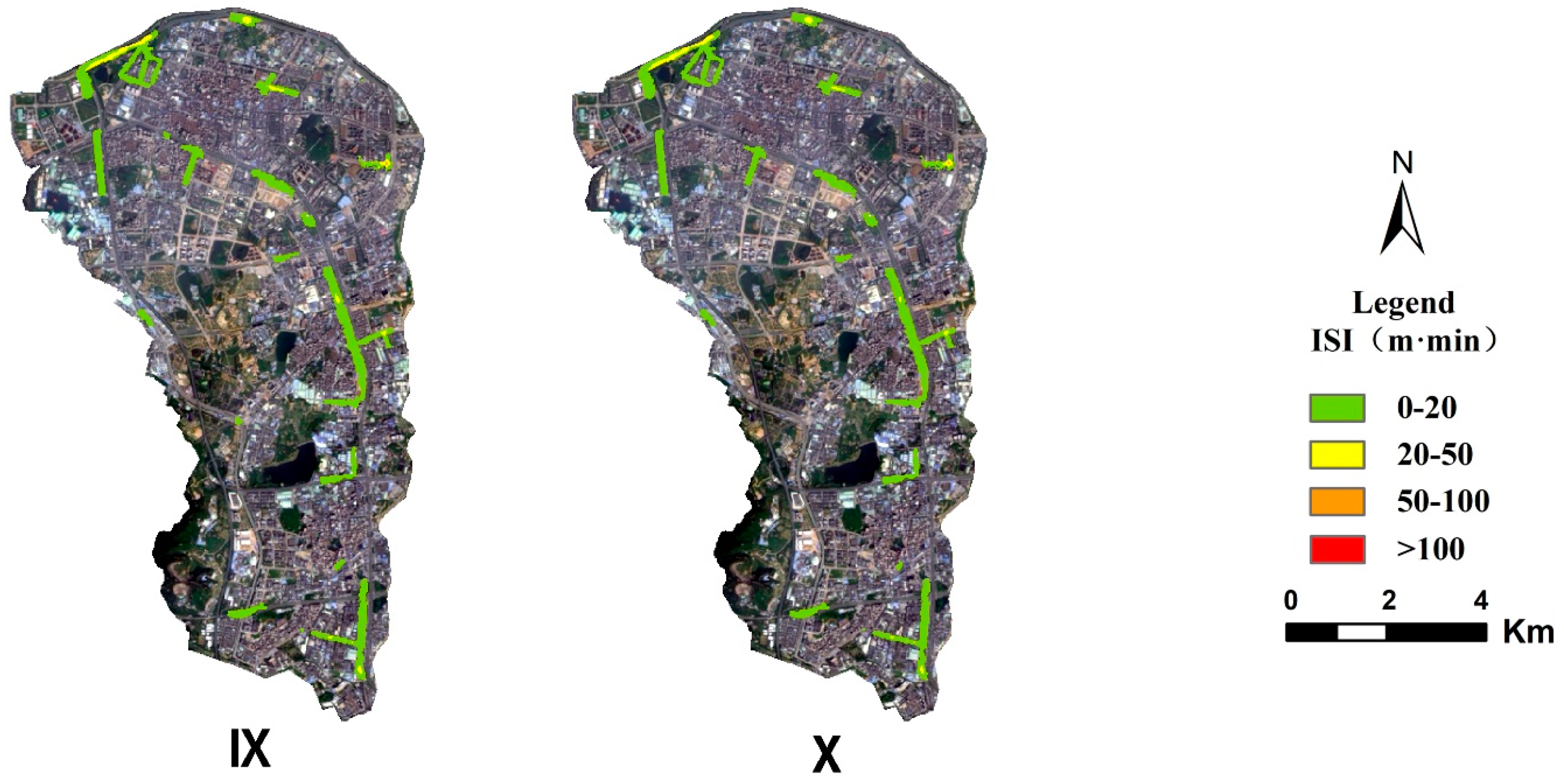
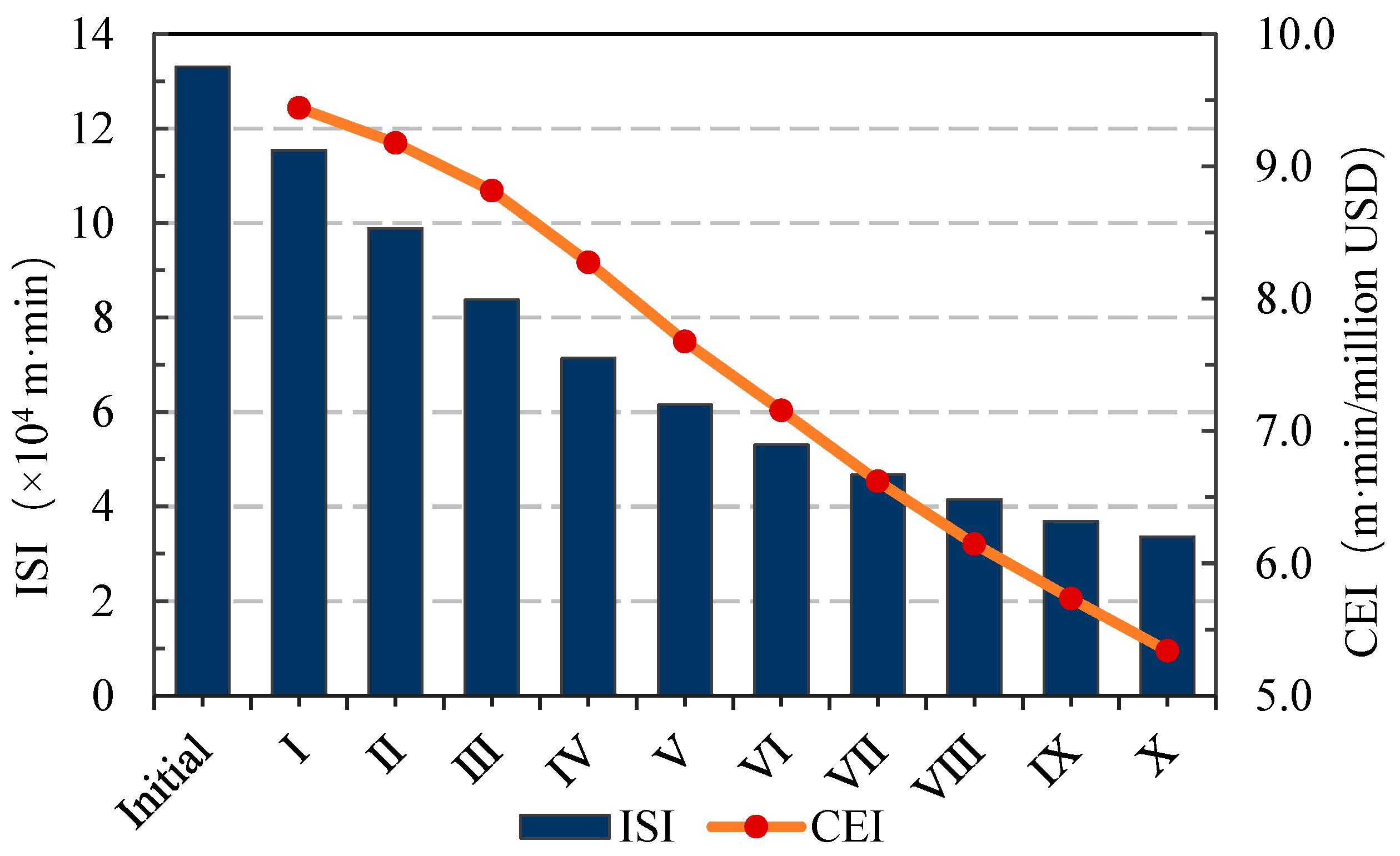
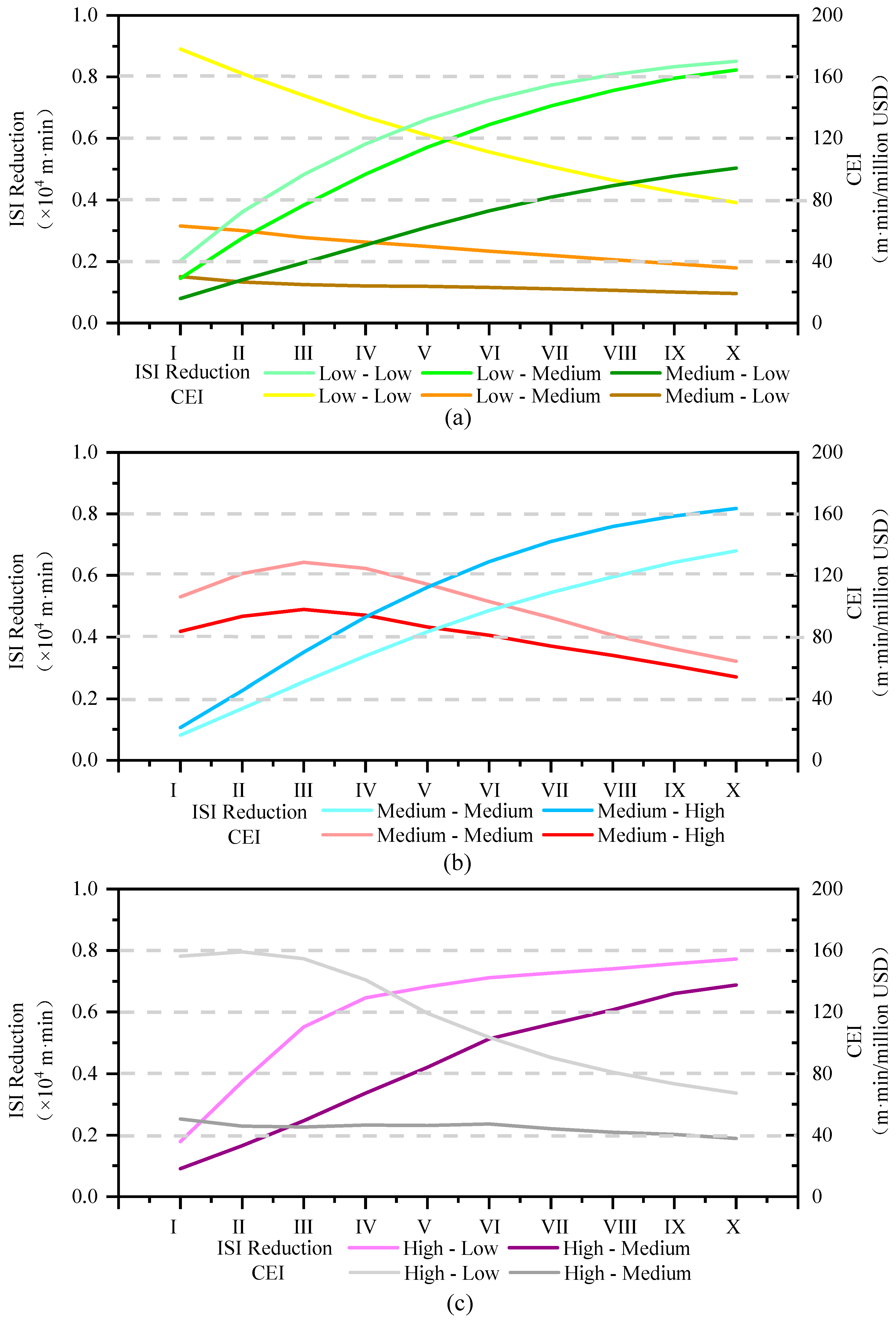
| Type | Use | Source |
|---|---|---|
| Land use data | Simplified to six types: commercial residential land, urban village, industrial land, park and green land, roads and others | Shenzhen Municipal Government |
| Digital Elevation Model(DEM) | Extracting slope and aspect, and identifying the catchment area | Geospatial Data Cloud (http://www.gscloud.cn/) |
| Soil data | Reference for soil infiltration rate | Natural resource survey results in Shenzhen |
| Pipe network data | Characterizing the drainage capacity of urban systems | Shenzhen Municipal Government |
| Hourly rainfall data | Input for rainstorm model | Shenzhen Meteorological Data System (https://data.szmb.gov.cn/) |
| Building census data | Identifying non-submerged areas | Shenzhen City Planning and Land Resources Committee |
| Inundation points in shapefile format | Calibrating and validating the model parameters | Shenzhen SanFang headquarters and Guangming New District Urban Construction Bureau |
| Inundation Area | Average Inundation Depth | |||
|---|---|---|---|---|
| Value (km2) | Reduction Rate | Value (m) | Reduction Rate | |
| Initial scenario | 1.596 | 0.09 | ||
| Scenario I | 1.386 | 13% | 0.08 | 15% |
| Scenario II | 1.231 | 23% | 0.07 | 28% |
| Scenario III | 1.126 | 29% | 0.06 | 38% |
| Scenario IV | 1.026 | 36% | 0.05 | 45% |
| Scenario V | 0.941 | 41% | 0.05 | 50% |
| Scenario VI | 0.882 | 45% | 0.04 | 53% |
| Scenario VII | 0.842 | 47% | 0.04 | 56% |
| Scenario VIII | 0.801 | 50% | 0.04 | 58% |
| Scenario IX | 0.767 | 52% | 0.04 | 60% |
| Scenario X | 0.741 | 54% | 0.03 | 62% |
| Density | Reduction Rate | CEI (m·min/Million USD) | ||||
|---|---|---|---|---|---|---|
| GR | PP | VS | GR | PP | VS | |
| 10% | 4% | 5% | 0.2% | 131.43 | 215.00 | 27.14 |
| 20% | 9% | 9% | 0.4% | 137.14 | 212.14 | 30.71 |
| 30% | 13% | 14% | 0.5% | 139.29 | 215.00 | 27.86 |
| 40% | 19% | 18% | 0.6% | 147.14 | 219.29 | 26.43 |
| 50% | 24% | 23% | 0.9% | 150.71 | 221.21 | 29.29 |
| 60% | 29% | 28% | 1.0% | 152.86 | 221.76 | 27.14 |
| 70% | 34% | 32% | 1.3% | 153.57 | 220.00 | 29.29 |
| 80% | 39% | 37% | 1.7% | 152.86 | 218.57 | 34.29 |
| 90% | 44% | 41% | 2.0% | 150.71 | 216.43 | 35.00 |
| 100% | 47% | 45% | 2.1% | 147.86 | 212.86 | 34.29 |
| ISI (m·min) | Reduction (m·min) | Reduction Rate | Cost (Million USD) | CEI (m·min/Million USD) | |
|---|---|---|---|---|---|
| Initial scenario | 46,308 | — | — | — | — |
| Scenario III | 32,781 | 13,527 | 29% | 82.32 | 164.29 |
| Optimal solution | 28,090 | 18,218 | 39% | 102.48 | 177.86 |
© 2020 by the authors. Licensee MDPI, Basel, Switzerland. This article is an open access article distributed under the terms and conditions of the Creative Commons Attribution (CC BY) license (http://creativecommons.org/licenses/by/4.0/).
Share and Cite
Wu, J.; Chen, Y.; Yang, R.; Zhao, Y. Exploring the Optimal Cost-Benefit Solution for a Low Impact Development Layout by Zoning, as Well as Considering the Inundation Duration and Inundation Depth. Sustainability 2020, 12, 4990. https://doi.org/10.3390/su12124990
Wu J, Chen Y, Yang R, Zhao Y. Exploring the Optimal Cost-Benefit Solution for a Low Impact Development Layout by Zoning, as Well as Considering the Inundation Duration and Inundation Depth. Sustainability. 2020; 12(12):4990. https://doi.org/10.3390/su12124990
Chicago/Turabian StyleWu, Jiansheng, Ying Chen, Rui Yang, and Yuhao Zhao. 2020. "Exploring the Optimal Cost-Benefit Solution for a Low Impact Development Layout by Zoning, as Well as Considering the Inundation Duration and Inundation Depth" Sustainability 12, no. 12: 4990. https://doi.org/10.3390/su12124990




